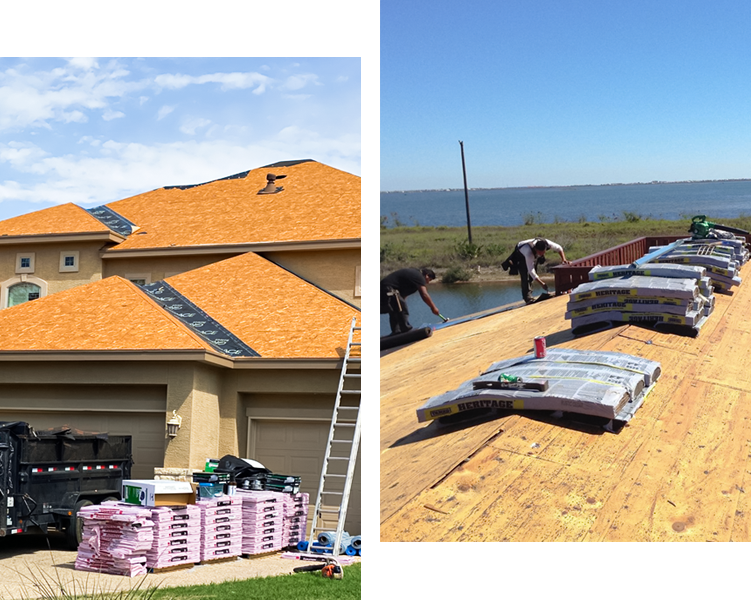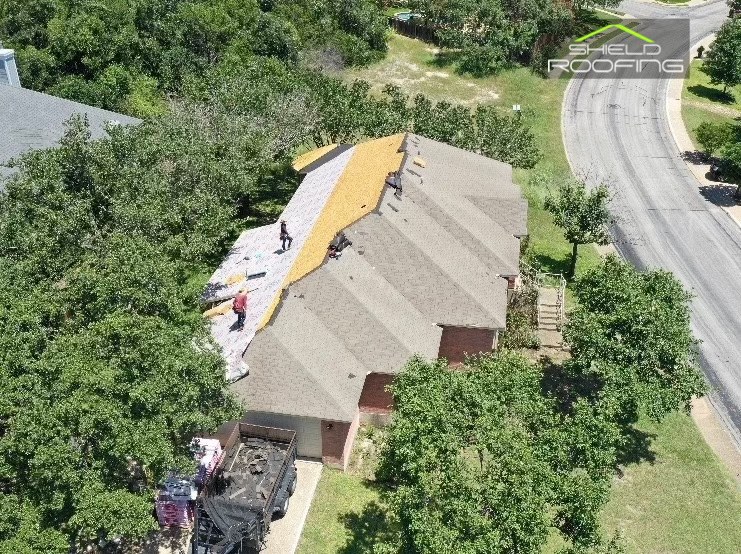Roofs are essential components of buildings and structures in Texas. They provide protection from the elements, as well as offering insulation to keep energy costs low. It is important for homeowners to understand how often they should replace their roof in order to ensure that it remains safe and effective over time.
In Texas, extreme weather can cause significant damage to roofs if they are not regularly maintained or inspected by a professional contractor. The average life expectancy of a roof depends on its material type; asphalt shingles typically last between 15-30 years while metal roofing can last up to 50 years.
In addition to the lifespan of the roof’s materials, climate can also affect how long it lasts; intense UV radiation and strong winds caused by hurricanes may decrease its durability quicker than normal wear and tear would do so.
Furthermore, regular maintenance is necessary for any kind of roof in order to extend its life cycle. Homeowners need to have their roofs checked at least once a year by professionals who know when repairs or replacements are needed based on their experience and knowledge of local building codes and regulations. Having this done annually helps detect small problems before they become larger ones, potentially saving costly repair bills down the line.
Description Of Different Roof Types
Roofs come in a variety of materials, such as asphalt shingles, metal panels, clay tiles and slate. Asphalt shingles are the most popular roof material due to their affordability, low maintenance requirements and easy installation. Metal roofs are durable and provide excellent protection from wind, hail and fire. Clay tile is an attractive option that can last up to 50 years with proper maintenance. Slate roofs offer superior durability but require heavy-duty framing for support and regular maintenance to prevent water damage.
The expected lifespan of each type of roof depends on many factors including climate, weather conditions, quality of materials used and frequency of maintenance or repair services performed over time. In Texas, where extreme weather conditions can cause significant wear and tear on roofs, it is important to assess the condition of your roof regularly to be sure it is able to withstand the elements.
Weather Conditions In Texas
Texas is a state known for its diverse climate. The weather in Texas can vary significantly from region to region, as well as seasonally. In the northern regions of the state, winters are typically mild with rain or snow occasionally occurring during winter months. Summers tend to be hot and humid with temperatures reaching into the mid-90s Fahrenheit (35°C). In southern regions such as San Antonio and Houston, summers are even hotter than those found in northern areas. Average summer high temperatures reach above 100 degrees Fahrenheit (38°C). Additionally, some parts of Texas experience heavy thunderstorms and floods during spring and summer months due to frequent large amounts of rainfall.
Due to this wide range of climatic conditions, it is important that homeowners understand how these factors will affect their roofing systems over time. It is generally recommended that roofs should be inspected annually by a professional inspector and replaced every 10-15 years depending on the type of material used. Roofs made of asphalt shingles may last up to 20 years while metal roofs may last up to 50 years if properly maintained. Homeowners should also take into consideration any damage caused by severe weather or other unforeseen events when deciding whether or not they need to replace their roof sooner than expected.
Impact Of Climate On Roof Lifespan
The climate of Texas can have a major impact on the lifespan of roofs. Hot temperatures and high levels of humidity can cause rapid deterioration of roofing material, while extreme cold weather may also contribute to damage over time due to contraction and expansion cycles.
Additionally, intense storms with hail or high winds can lead to significant damage that requires repairs or replacement. It is important for homeowners in Texas to inspect their roof annually and repair any minor damages found before they worsen over time. This will help ensure that the roof lasts as long as possible without needing complete replacement.
It is generally recommended that roofs are replaced every 20-30 years depending on their condition; however, this timeline could be shorter if it has been exposed to particularly harsh environmental conditions or neglectful maintenance practices. Homeowners should stay informed about local climate changes and take action when necessary by scheduling inspections, making repairs, and considering replacing old roofs sooner than later if needed.
Quality Of Materials Used
The quality of materials used in roof replacement is an important factor to consider when determining how often roofs should be replaced. Long-lasting, durable materials that are able to withstand the elements will extend the life of a roof and require less frequent maintenance or repairs. Common roofing material options for Texas homeowners include asphalt shingle, wood shake, metal and tile. Asphalt shingle roofs tend to last around 20 years while metal can last up to 50 years before needing a replacement. Wood shake and tile have a lifespan of 30–40 years depending on upkeep and maintenance. In addition, the type of climate experienced in any given region should also play a role in deciding which material would be best suited for a particular area; with some areas more prone to extreme weather conditions than others. It is therefore important for Texans to research their local climate and select materials accordingly in order to maximize the longevity of their roof.
Professional Inspections And Maintenance
In Texas, roofing professionals recommend a professional inspection at least once every two years. Generally, this should be done in the spring or fall months when temperatures are moderate and conditions conducive to thorough inspections. During an inspection, multiple factors will be evaluated including age of current material, signs of damage due to weather events, levels of deterioration and other considerations that can affect the overall condition of the roof.
If any issues are identified during an inspection, maintenance may need to be completed as soon as possible. This might include minor repairs such as replacing missing shingles or flashing; more extensive work may involve major repairs like partial re-roofs or full replacements.
Typically, for asphalt roofs in good condition with no visible signs of wear and tear, a full replacement is recommended after 20 years. However, depending on local climate conditions and other circumstances related to the specific roof system being evaluated by a professional inspector, it could be less than 20 years before needing a new roof installation.
Advantages Of Regular Replacements
Replacing a roof in Texas regularly can be beneficial for multiple reasons. Firstly, it is important to understand that roofs are exposed to both the sun and rain year-round, thus causing wear and tear over time. Regular replacements ensure that any damage that has been caused by weather or other factors is addressed quickly and efficiently. Additionally, regular roof replacement helps maintain its structural integrity as old shingles may become weak or brittle due to age. This makes sure that the home remains safe from potential hazards such as leaks or animal invasions. Furthermore, replacing an aging roof with newer materials also increases energy efficiency by reducing heat loss through insulation gaps between tiles. Finally, regular maintenance of the roof will help extend its lifespan and improve curb appeal, increasing the overall value of the property in question.
Cost Considerations
The cost of replacing a roof in Texas can vary significantly depending on the size, complexity and materials used. It is usually more expensive to replace an entire roof than to repair it due to added labor costs associated with removing old shingles and disposing of them properly.
Additionally, if the underlying structure needs repairs or reinforcement before new shingles are laid down, this will add to the overall cost of replacement. The type of material chosen for the project also affects its total cost; asphalt shingle roofs tend to be less expensive while metal and cedar shake roofs may require a higher investment up-front.
Other factors such as permits, debris removal, warranties, contractor fees and taxes should all be factored into the budget when determining how much it will cost to replace a roof in Texas. Ultimately, homeowners should do research ahead of time so that they understand what their expenses might be prior to committing themselves financially.



